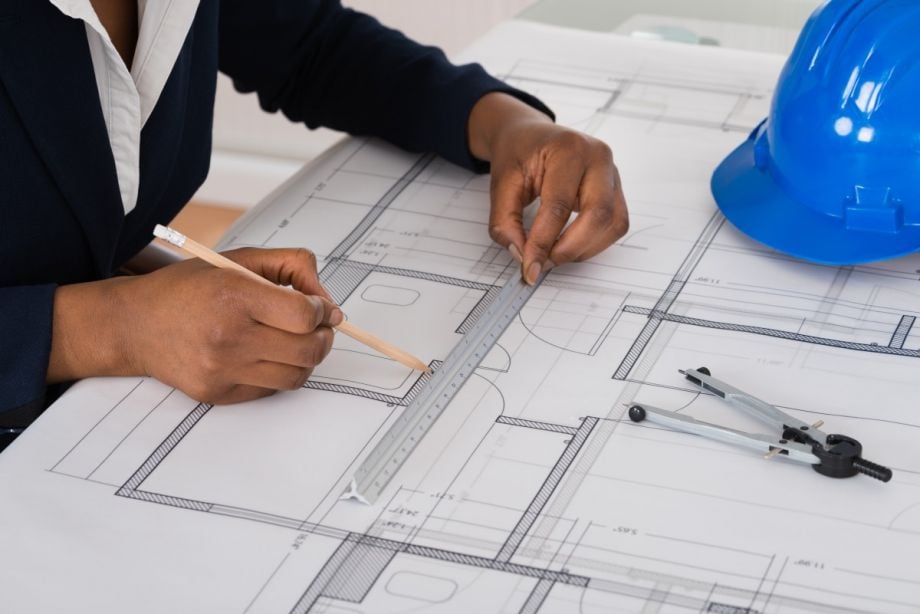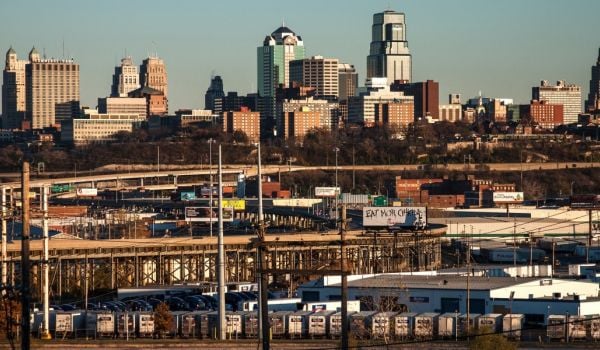Of all the resources denied or extracted from historically disenfranchised and marginalized communities — public and private investment, living wages, healthcare, education — good design might seem like an afterthought. But when you start to peel back the layers of the onion that leads to resources denied or extracted, you can find architects at almost every turn, and the pattern of where good design and bad design goes is just as predictable and frustrating as redlining or child asthma rates by zipcode or mass incarceration rates by race.
No single architect or investor or prosecutor is solely responsible for the historic pattern of their profession — it’s systemic, as Kimberly Dowdell explains in the Q&A below. Currently a principal at global architecture firm HOK, based in the firm’s Chicago studio, Dowdell is also in the middle of serving a two-year term as president of the National Organization of Minority Architects (NOMA), which is working to address disparities like the fact that out of 115,000 licensed architects in the U.S., only 2,300 are black and fewer than 500 are black women. Previously, Dowdell has worked as a real estate developer in her hometown of Detroit, as well as in the city of Detroit’s Housing and Revitalization Department. She’s also a co-founder of the Social Economic Environmental Design Network. And she was a 2013 Next City Vanguard.
This conversation has been edited for length.
Here’s a confession: I don’t typically interview architects. What am I missing?

Kimberly Dowdell (courtesy National Organization of Minority Architects)
Architects add a lot of value to everything that we design. Someone hires us because they have a vision and we help to articulate that vision and help to bring it to fruition. And I think the work that we do is undervalued. I was just having a meeting with the American Institute of Architects, which has a close relationship with NOMA. We were talking about how it’s difficult for someone who comes from an under-resourced kind of family background to choose architecture because they probably just don’t have access to any architects or what architects do in their earlier years, but also the fact that the education of an architect is either five, six or seven years or longer in some cases. And that doesn’t even include the licensure process, which is another few years, generally. So what becomes even more troubling for those who have to navigate becoming an architect and not having a well-resourced family background is that the compensation of an architect doesn’t really relate well to what architects do, the value that architects create, particularly in the urban context. I think society undervalues what architects do pretty dramatically. I think that thoughtful design comes from having a more diverse array of people to contribute to it. Architects should be paid more for the value that we provide. And then by virtue of that, architecture can actually attract more talent and more diverse talent, which will create a better end product for everyone.
So what I’m hearing is that architecture as a field is also a resource that all communities should have access to, but the way development and architecture work right now, it makes architecture or good design hard to access for certain communities.
I think that if we diversify the profession, that actually creates more opportunities for people to actually work on the communities that they’re from. It can be politically important. I remember in Detroit, where I had the privilege of actually presenting a couple of projects to City Council, I would get the question, well, do you have anyone else on the team who’s black or why didn’t you choose a Detroiter. Political leaders can get involved, asking those kinds of questions because guess what they have constituents they have to answer to. They’re concerned about not getting the votes, if they’re not tough on those issues of equity. So it’s partly their job to make sure that they’re asking these questions, and to make sure the developers and the teams that are trying to economically benefit from places like Detroit, that they are building diverse teams and actually representing the people that are being served.
How do you define equity?
I very simply define equity as making it right. I think oftentimes things happen, policies are implemented, they have unintended consequences, or quite frankly, sometimes they’re just reckless policies — for example, redlining — that had very negative impacts. I think equitable development is about acknowledging the wrongs of the past, the harm that’s been done, whether intentional or not, and providing some level of remedy to that, whatever that might be. That’s my broad definition of what equitable development is. If that particular community has been displaced, making an effort to acknowledge that and to actually invest in creating a space to, in essence, apologize. There’s an example in Vancouver, British Columbia, where the Canadian government said, “we apologize for having done this to this particular community, and we’re now investing in this urban intervention, that pays homage to that history but also helps to build a better future.” That’s a really good example of equitable development. Making it right. You can never fully repair these things, but I think the gesture is an important one.
Do you still find yourself talking to others having to sell the idea of equitable development as something that architects should be concerned about?
I think increasingly, communities are requiring that. As politicians get more and more involved in the development process, architects are going to have to be able to respond and do meaningful community engagement and their design solution has to really incorporate, in a real way, what the community feedback was, and so I think increasingly, that’s just going to be standard. I’ve been in the profession for about 15 years now, and I also think that there’s more activism around those issues. Citizens are being better informed about some of these disparities, and then they’re being more vocal with their politicians and politicians are now having to respond to sort of this real effect and it’s starting to happen more.
The politicians — the clients, so to speak — are becoming more diverse. Is that adding to the emphasis on equity and community engagement?
If a politician is representing, for example, a mostly black constituency, and if a project’s design team has no one on it who’s black I’m pretty sure they’re going to have to say something to that. It’s the design team’s job to look inwardly and say, who else within the company —who’s qualified, obviously — can be a part of this team so that we can actually better represent their interests. And I don’t think that necessarily that it has to be an all-black design team or development team has to be all-black to be successful in delivering a good project. But I do think within that diversity, there should be some level of representation from the community, even if it’s someone who didn’t grow up in that particular community, but they at least have some level of shared experiences.
At NOMA, a lot of the work I see you’re doing is about both attracting more diverse talent to architecture as well as retaining that talent — teaching financial planning and sustainability as a smaller firm or a freelance architect. Helping them subcontract or partner with larger firms who may not have the necessary diversity of talent in-house.
That’s also something that I’m bringing to HOK. I think HOK does a good job with creating awareness around diversity. Everyone acknowledges there aren’t enough minorities in architecture, period, so there’s no firm big small or medium that completely nails it. But I think HOK and other firms like Perkins+Will and Gensler, they have initiatives that are set up to to create mentorship opportunities and diversity scholarships and diversity committees and all these things that are important to helping people feel that sense of belonging, and that’s important for retention. But one specific thing that I’m implementing that I don’t know that any other firm has done is creating a really strategic approach around teaming. We’re working on creating a smart database of all the different team members that we partner with, including other architecture firms, but also we also often partner with engineers and other types of consultants. That program is called HOK Mosaic. And it’s about bringing together all these different pieces to create this larger picture that best serves a client.
And again, the idea is that making the profession more equitable, more diverse, more representative of the communities that architects are serving makes everything they’re connected to, like development and real estate, more equitable.
Everything is interconnected. I’ll give another example from the city of Detroit where, you know, the city has a large proportion of publicly owned land. And so the city is tasked with ensuring that when they do convey the land to a private developer, that it’s done in a responsible way, and not just whoever the highest bidder is. One factor is community support. Have you had any community meetings? Who are you in touch with within that community? Are you designing this in a vacuum or do you actually have stakeholders who have seen this? So what does it look like? What does it feel like? How does it operate? What does it actually do to the urban context? Does the design actually facilitate your [financial projections] working? Will it make people want to live here or spend their time and money here? The physical design is really, really critical to the numbers working.
Right. And whether it’s a small project or big project, one of the questions that always pops up is, who is this for? And how does the community understand and perceive who is this project for? And what you just said right now, it reminds me that question is a design question. If a community doesn’t feel like this project is for them, design is probably a big reason why.
I think a better question is who is it with? Because as a designer, I feel like you’re not necessarily designing for a client you’re designing with a client, because, you know, your decisions are informed by what that client says their priorities are. But one thing I don’t have an answer for is, how do you define the stakeholders? Is it the people who have time to show up to the community meetings? Generally people who have time to go to these meetings are perhaps older adults who are perhaps retired, because younger adults who maybe are at work, or they have childcare responsibilities. Some communities actually provide childcare in a separate room with a certified childcare provider, so that people can actually come and engage and not be worried about that issue. There’s also the risk that the only people who get engaged are the people who pay to play. Defining stakeholders clearly is not something that we’ve really standardized, but I do think it’s important that there is a community engagement period and it depends on the project, how that’s done, hopefully it’s done in a way that’s also equitable.
And that speaks to the importance of why architects and architecture needs to be more diverse, because in order to do that equitably, to navigate those discussions and those challenges in communities that don’t look like most architects today, architects need to look different, and come from different backgrounds and places.
Yeah, there’s a book by Scott Page, it’s called “The Difference,” and it talks about the power of diversity to create better teams and schools and organizations and boards because just having a diversity of perspective is critical to making sure that you’re not missing anything because if everyone has the exact same experience and perspective on things then things get missed. I think our diversity is why we survived as a species.
This article is part of The Bottom Line, a series exploring scalable solutions for problems related to affordability, inclusive economic growth and access to capital. Click here to subscribe to our Bottom Line newsletter.

Oscar is Next City's senior economic justice correspondent. He previously served as Next City’s editor from 2018-2019, and was a Next City Equitable Cities Fellow from 2015-2016. Since 2011, Oscar has covered community development finance, community banking, impact investing, economic development, housing and more for media outlets such as Shelterforce, B Magazine, Impact Alpha and Fast Company.
Follow Oscar .(JavaScript must be enabled to view this email address)


















